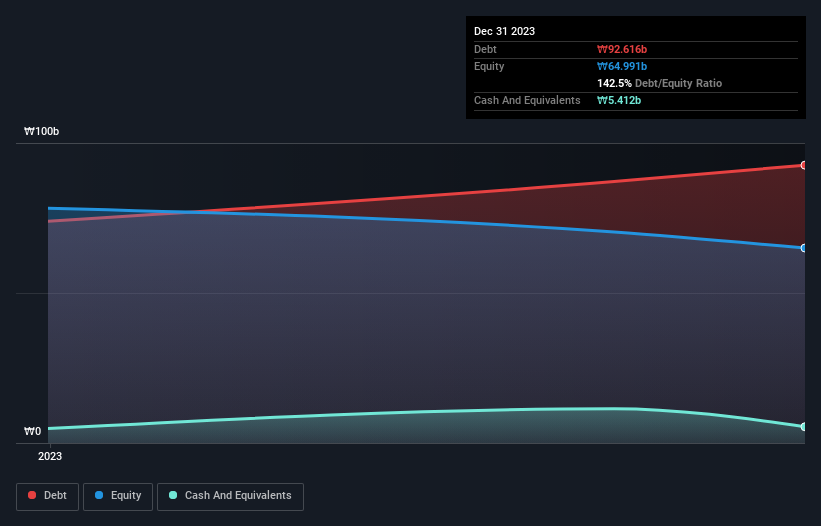- South Korea
- /
- Metals and Mining
- /
- KOSE:A133820
Health Check: How Prudently Does Fine besteel (KRX:133820) Use Debt?
Howard Marks put it nicely when he said that, rather than worrying about share price volatility, 'The possibility of permanent loss is the risk I worry about... and every practical investor I know worries about.' It's only natural to consider a company's balance sheet when you examine how risky it is, since debt is often involved when a business collapses. We can see that Fine besteel. Co., Ltd. (KRX:133820) does use debt in its business. But should shareholders be worried about its use of debt?
When Is Debt Dangerous?
Debt assists a business until the business has trouble paying it off, either with new capital or with free cash flow. In the worst case scenario, a company can go bankrupt if it cannot pay its creditors. However, a more frequent (but still costly) occurrence is where a company must issue shares at bargain-basement prices, permanently diluting shareholders, just to shore up its balance sheet. Of course, debt can be an important tool in businesses, particularly capital heavy businesses. The first step when considering a company's debt levels is to consider its cash and debt together.
Check out our latest analysis for Fine besteel
What Is Fine besteel's Debt?
As you can see below, at the end of December 2023, Fine besteel had ₩92.6b of debt, up from ₩73.9b a year ago. Click the image for more detail. However, it also had ₩5.41b in cash, and so its net debt is ₩87.2b.

How Strong Is Fine besteel's Balance Sheet?
According to the last reported balance sheet, Fine besteel had liabilities of ₩119.6b due within 12 months, and liabilities of ₩5.73b due beyond 12 months. Offsetting this, it had ₩5.41b in cash and ₩32.0b in receivables that were due within 12 months. So its liabilities total ₩87.8b more than the combination of its cash and short-term receivables.
This deficit casts a shadow over the ₩43.7b company, like a colossus towering over mere mortals. So we'd watch its balance sheet closely, without a doubt. At the end of the day, Fine besteel would probably need a major re-capitalization if its creditors were to demand repayment. When analysing debt levels, the balance sheet is the obvious place to start. But it is Fine besteel's earnings that will influence how the balance sheet holds up in the future. So when considering debt, it's definitely worth looking at the earnings trend. Click here for an interactive snapshot.
Over 12 months, Fine besteel made a loss at the EBIT level, and saw its revenue drop to ₩132b, which is a fall of 5.3%. That's not what we would hope to see.
Caveat Emptor
Over the last twelve months Fine besteel produced an earnings before interest and tax (EBIT) loss. Its EBIT loss was a whopping ₩20b. Considering that alongside the liabilities mentioned above make us nervous about the company. We'd want to see some strong near-term improvements before getting too interested in the stock. Not least because it had negative free cash flow of ₩13b over the last twelve months. That means it's on the risky side of things. There's no doubt that we learn most about debt from the balance sheet. However, not all investment risk resides within the balance sheet - far from it. To that end, you should learn about the 3 warning signs we've spotted with Fine besteel (including 1 which is significant) .
If you're interested in investing in businesses that can grow profits without the burden of debt, then check out this free list of growing businesses that have net cash on the balance sheet.
New: AI Stock Screener & Alerts
Our new AI Stock Screener scans the market every day to uncover opportunities.
• Dividend Powerhouses (3%+ Yield)
• Undervalued Small Caps with Insider Buying
• High growth Tech and AI Companies
Or build your own from over 50 metrics.
Have feedback on this article? Concerned about the content? Get in touch with us directly. Alternatively, email editorial-team (at) simplywallst.com.
This article by Simply Wall St is general in nature. We provide commentary based on historical data and analyst forecasts only using an unbiased methodology and our articles are not intended to be financial advice. It does not constitute a recommendation to buy or sell any stock, and does not take account of your objectives, or your financial situation. We aim to bring you long-term focused analysis driven by fundamental data. Note that our analysis may not factor in the latest price-sensitive company announcements or qualitative material. Simply Wall St has no position in any stocks mentioned.
About KOSE:A133820
Mediocre balance sheet with very low risk.
Market Insights
Community Narratives




